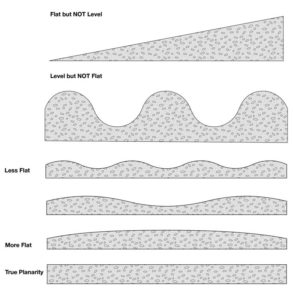Concrete chronicles: Achieving floor flatness and levelness

By Chris Bennett, iSCS, CDT, James Longo, iSCS, and Keith Robinson, FCSC, FCSI, RSW, LEED AP
Concrete floors are used in wide-ranging facilities, such as industrial data centres, commercial high-rise buildings, and residential homes. Concrete floor quality depends on several factors, including the concrete mix design, the curing process, including consolidation and finishing. However, one of the seemingly simple, but often complex aspects of concrete floors, impacting performance and functionality, are floor flatness (FF) and floor levelness (FL).
In a world where project manuals require competing benchmarks for concrete and flooring, as well as vagueness on responsibility within the flatwork and flooring trades for ultimate responsibility for FF/FL, it is important to understand these two factors and how they affect not only the overall quality of concrete floors (and other floor finishes), but what is the best way to go about designing and specifying for the best outcome possible.
Floor flatness and floor levelness
Floor flatness refers to the smoothness and uniformity of the concrete surface. It is measured by calculating the height difference, between the highest and lowest points on the surface over a specified distance. The flatness of a concrete floor is critical in many applications, especially in commercial and industrial settings where heavy machinery and equipment are used. A flat floor ensures the equipment operates smoothly and efficiently, reduces the risk of damage to the machinery, and improves safety for workers. A non-flat floor can also cause problems with the installation of flooring materials, such as tiles or carpeting, which require a level surface (Figure 1).

Floor levelness refers to the evenness of the concrete floor in terms of its slope and elevation. It is measured by calculating the difference in height between the floor surface and a designated reference point, such as a horizontal plane. Floor levelness is essential for various applications, such as building foundations, where a level floor ensures the load is evenly distributed and the structure remains stable. It is also critical in commercial and industrial settings where liquids are stored or transported, such as food processing plants, where a level floor ensures the liquids flow uniformly and do not accumulate in certain areas.
Levelness and flatness
To achieve the desired level of flatness and levelness in concrete floors, various techniques and tools are used. Getting consistent FF and FL on concrete slabs requires careful planning, execution, and quality control (QC) throughout the construction process.







